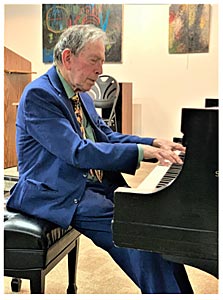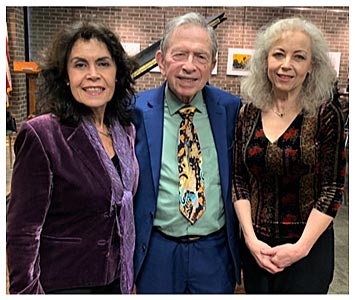Music Educators Association of New Jersey
Serving teachers and students since 1927


 When Jerry Lowenthal was a student, playing Scriabin's 6th Piano Sonata was still something of a rarity. It was Eduard Steuermann, Jerry's mentor at the Juilliard School, who gave Scriabin's 6th Sonata, Op. 62, composed in 1911, its Carnegie Hall debut in 1955.
When Jerry Lowenthal was a student, playing Scriabin's 6th Piano Sonata was still something of a rarity. It was Eduard Steuermann, Jerry's mentor at the Juilliard School, who gave Scriabin's 6th Sonata, Op. 62, composed in 1911, its Carnegie Hall debut in 1955.
Mr. Lowenthal was attracted to the work because it was so exotic and because it was known that Scriabin was afraid of it. Mr. Lowenthal took part in the 1958 Tchaikovsky Competition and while he was in Moscow, Heinrich Neuhaus, professor at the Moscow Conservatory, invited him to perform at the Scriabin Museum. Mr. Lowenthal played the 6th Sonata. In subsequent years, Mr. Lowenthal has played more Romantic Scriabin pieces as encores.
Alexander Scriabin wrote ten piano sonatas. The last five are in a different world in many ways. He combines strict classical forms with radical world views. The sonatas are composed in vigorous classical terms combined with wildness to the point of paradox. Beginning in 1905 Scriabin was influenced by Mme. Helena Blavatsky's Theosophy. It was fashionable to be a mystic. Scriabin believed in the relationship of music to colors and perfumes and imagined his later works as “preparation for a “supreme ecstatic mystery which would accompany a final cataclysm” (from the Oxford Dictionary of Music, Fourth Edition, 1996).
The first theme of the one movement 6th Sonata is mysterious, concentrated, strange. It contains heat and mysterious wind. The second theme is full of clarity and sweetness; it charms us. Then something frightening arises. We hear mysterious calls, some joyful and triumphant. When the second theme returns, we hear a delirious dance. Scriabin never played this sonata. He thought it dark and satanic (versus divine) and he was afraid of it.
Regarding classical form, the piece is composed in 4-measure phrases. They return with embroidery. The piece is not in any key, although Scriabin said it was in G Major. Regarding the harmonies, Scriabin's favorite chord is the French 6th which he never resolves to a dominant 7th. This lack of resolution gives the first theme an odd tension. He composes progressions of thirds, makes sequences of these progressions, and moves from one dominant 7th to another.
 In the Development, the complementary second theme is in the tritone key (therefore, if the piece is written in Scriabin's declared G Major, the tritone key would be in C-sharp or D-flat). He continues in the classical style of combining phrases, the mysterious call pianistically enriched. Scriabin never resolves in another key. The themes and harmonies are the same. He wraps up the second theme by moving up in thirds. There is a new closing subject, a triad in first inversion with a tritone underneath.
In the Development, the complementary second theme is in the tritone key (therefore, if the piece is written in Scriabin's declared G Major, the tritone key would be in C-sharp or D-flat). He continues in the classical style of combining phrases, the mysterious call pianistically enriched. Scriabin never resolves in another key. The themes and harmonies are the same. He wraps up the second theme by moving up in thirds. There is a new closing subject, a triad in first inversion with a tritone underneath.
The entire Recapitulation is a whole-tone down. The Coda alternates a delerious dance with frightening harmonic progressions of sequences inverted by tritone. Some of Scriabin's descriptions written into the music of this delerious dance were more scary in the words than in the music. He even wrote a high D (not on the piano) into this work.
Scriabin has been criticized for his mystical and color associations. We don't know whether he actually saw these colors. (Olivier Messiaen had an idea that every pitch has some immediate association with a color.) Mr. Lowenthal questioned: should we worry about metaphysical associations? “You cannot play unless you are spiritual (religious)” seems old hat. What is a black mass (subtitle of Scriabin's 9th Sonata)? Investigate 19th century literature. When Liszt wrote Totentanz he had the devil in mind. Liszt was a devout Catholic, so it is not clear who wins at the last. We can't take Scriabin's philosophy seriously. In his 7th Sonata, he constructed a “mystic chord” – a series of 4ths (C, F-sharp, B-flat, E, A and D. He composed dark chords but they upset him.
 Scriabin took his written descriptions seriously. The sonatas were put together mathematically, but it helps to understand what he was thinking. This is true about all music that we play; we learn their world view from what composers write. “We're like actors, we have to identify with them.” The conductor William Steinberg, in discussing Scriabin, declared that he was imprisoned in 4- measure phrases and that he was afraid of falling into the abyss. Scriabin's popularity follows the pattern in music which also happens in literature. John Updike said, “I want to write what satisfies me. My books may one day be forgotten, but if they are good, they will come back.” Vincent D'Indy's works were once so much played, then disappeared from concert programs. Elliott Carter, at the age of 100, declared that after his death he would not be surprised if his music dies in popularity.
Scriabin took his written descriptions seriously. The sonatas were put together mathematically, but it helps to understand what he was thinking. This is true about all music that we play; we learn their world view from what composers write. “We're like actors, we have to identify with them.” The conductor William Steinberg, in discussing Scriabin, declared that he was imprisoned in 4- measure phrases and that he was afraid of falling into the abyss. Scriabin's popularity follows the pattern in music which also happens in literature. John Updike said, “I want to write what satisfies me. My books may one day be forgotten, but if they are good, they will come back.” Vincent D'Indy's works were once so much played, then disappeared from concert programs. Elliott Carter, at the age of 100, declared that after his death he would not be surprised if his music dies in popularity.
Regarding Scriabin, it is a cultural question: is his music lush exoticism or Post-Romanticism? Stravinsky's Quatre Études (Op. 7 from 1908) sound like Scriabin, but then Stravinsky moved to Neo-Classicism. Scriabin did not belong in that world. He quoted the communist manifesto in one of his works. He was told: “if you do that you'll lose popularity in the press. Your works will be called decadent.” In Mr. Lowenthal's opinion, today the Sixth Sonata would be the music of the “turned on;” the music of the “drug culture.”

MEA-NJ President Yudit Terry and Meeting Hostess Sophia Agranovitch with our presenter Jerome Lowenthal
Beverly Shea, Writer & Layout
Lisa Gonzalez, Photography